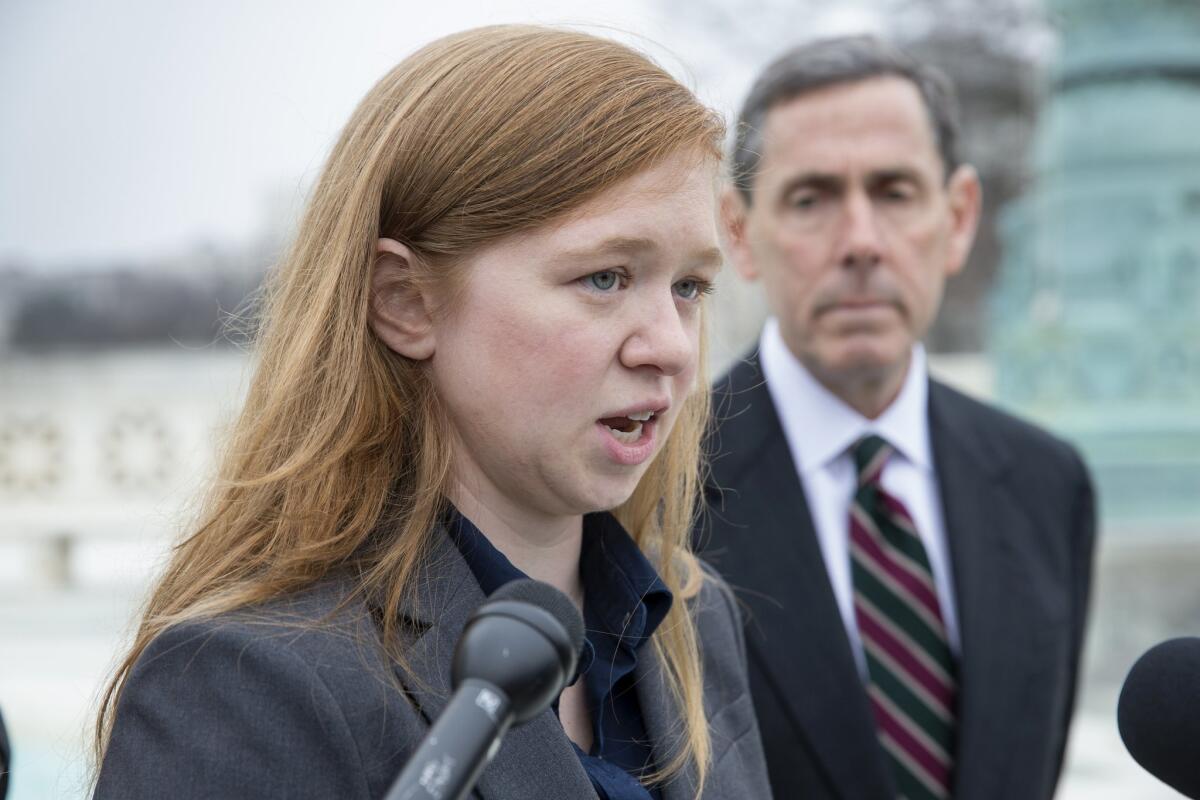Conservative legal strategist has no office or staff, just a surprising Supreme Court track record

Abigail Fisher, who challenged the use of race in college admissions, is joined by Edward Blum outside the Supreme Court this month.
- Share via
Reporting from Washington — The most effective legal strategist before the Supreme Court these days is a retired stockbroker and liberal-turned-conservative who admits he sometimes finds plaintiffs by cold-calling strangers on the phone.
“I don’t have a staff or an office,” or for that matter, a law degree, said Edward Blum, 63. He researches his cases on a laptop and describes his Project on Fair Representation as “me and a website.”
But Blum offers something that has proved far more important: a conservative take on 1960s-era civil rights principles that has won favor with the high court. These include the idea that the government may not consider race, even if it’s to help minorities, and that election districts must be equal, based on the “one person, one vote” rule.
With the fierce focus of an outsider, Blum has put those issues squarely before the Supreme Court justices, who last month debated two Blum-backed cases: one over who should count when election districts are drawn and another about whether race can still play a role in college admissions.
Typically, the justices vote to hear a case when lower courts are divided, but occasionally an appeal poses an entirely new question and asks the justices to upset a long-settled practice. These are the kinds of cases that Blum has succeeded in bringing to the court.
His ideas are radically conservative. ... But in person, he is a soft-spoken, friendly guy.
— Jon M. Greenbaum, chief counsel for the Lawyers Committee for Civil Rights, which opposes Blum in affirmative action and election districts cases
In his biggest victory to date, Blum challenged the Voting Rights Act of 1965 as outdated and a recipe for “racial gerrymandering” of election districts. The law had required some Southern states to win approval from the Justice Department before changing their election laws. The Supreme Court agreed with Blum’s position in 2013, striking down that provision.
“He has had a remarkable run,” said Ilya Shapiro, a lawyer for the libertarian Cato Institute. Shapiro describes Blum as the “architect” of the strategy even though he prefers to stay behind the scenes. “He is not an angry guy who wears an agenda on his sleeve.”
Civil rights advocates say Blum’s victory in the Voting Rights Act case “gutted” the measure and allowed Republican-led states to pass voter ID laws that now threaten voting by minorities.
“His ideas are radically conservative,” said Jon M. Greenbaum, chief counsel for the Lawyers’ Committee for Civil Rights Under Law, which opposes Blum in the affirmative action and election districts cases. “But in person, he is a soft-spoken, friendly guy.”
Blum says his cases often stem from personal experience, such as the election district case. Blum, a Texas native who now lives on the coast of Maine, knew from his time living in Houston that some of the city’s council districts had twice as many voters as others, even though they had equal numbers of total residents.
There, as in many parts of the nation, the growing population of immigrants has meant that some of the districts that elect a city council, a state legislature or the U.S. House of Representatives may have far fewer voters than others with the same total number of people.
Blum believed these stark differences were unconstitutional — a violation of the “one person, one vote” rule — and he focused on the Texas state Senate districts.
“I did it all on Google,” he said in an interview, describing how he went about setting up his case. “I identified the districts that were the most malapportioned.”
He found a rural and heavily Republican district in east Texas that had 574,000 adult citizens who could vote, and another, which included Brownsville on the Mexican border, that had only 350,000 eligible voters. Since both districts had about 800,000 residents according to the census data, they were each due one elected representative, Texas officials said.
First, Blum needed a plaintiff. “I looked for people who were active in Republican politics, and I made a dozen or more calls” before reaching the Republican Party chairwoman from Titus County. “When Sue Evenwel answered the phone, she was interested and agreed to be the plaintiff,” he said.
To no one’s surprise, a three-judge panel in Texas dismissed the case of Evenwel vs. Abbott and ruled that the state was fully justified in drawing districts based on their “total population,” which has been the common practice nationwide. The plaintiffs, the judges said, are “relying upon a theory never before accepted before the Supreme Court or a circuit court.”
But when the lawyers hired by Blum appealed, the justices voted to hear it, even though there were no conflicting rulings from other parts of the country.
In a rarity, lawyers for the Obama administration and Texas Gov. Greg Abbott found themselves on the same side, opposing Blum. They cited two powerful arguments for maintaining the current system.
The Constitution speaks of “counting the whole number of persons in each state” when dividing the House seats among the states. How can it be unconstitutional then to use the same count when dividing districts within a state? Justice Elena Kagan asked during Dec. 8 arguments. Others noted that census data are the most reliable available, although they include the count of all residents, not just citizens.
During the argument, however, the court’s conservatives said they were troubled by what Justice Anthony M. Kennedy called the “huge disparity” in the voting population of the two Texas districts. A ruling in Blum’s favor could lead to a significant shift in political power, especially in states such as California with large immigrant populations.
Just presenting the issue to the court counts as a victory of sorts for Blum.
“Getting a case in front of the Supreme Court is much more difficult than winning there,” said James Bopp Jr., a Terre Haute, Ind., lawyer whom some compare with Blum. About 99% of the more than 8,000 cases appealed annually to the high court are turned down without a hearing.
Bopp, a staunch antiabortion activist, filed a series of free-speech lawsuits challenging campaign-funding limits. One of them, the Citizens United case, led to the 2010 ruling that struck down the laws that banned campaign spending by corporations.
Blum says he got interested in elections when he ran a losing campaign for a House seat in Houston in a district that he says was drawn to elect a black Democrat.
He grew up in a solidly Democratic household and was a campus liberal at the University of Texas in Austin, but he shifted rightward in the 1980s when he was working at an investment firm. The congressional race was “probably unwinnable” for a Republican, Blum said, and he and his wife decided to walk the district, passing out leaflets and talking to voters. They discovered they were repeatedly crossing the district lines.
“We would talk to blacks on one side of the street and whites on the other. It was the most eye-opening part of it,” he recalled.
He lost as expected, and then he did the unexpected by filing a lawsuit contending that it was unconstitutional to draw the district lines based on race.
Finding a lawyer was hard. “I consulted with several lawyers who said that claim would go nowhere,” he said. Two prominent Washington attorneys said they would consider taking the case, but only for a $1-million retainer.
“I didn’t have that kind of money,” he said, but eventually he found a real estate lawyer in Monroe, La., who agreed to take the case for $7,000. Blum put his name on the suit, but made his lead plaintiff a campaign volunteer named Al Vera who had served in the Navy and taught civics in high school.
Three years later, in a case called Bush vs. Vera, the Supreme Court struck down the Texas districts as “racial gerrymanders,” saying that the “use of block-by-block racial data was unprecedented.”
Emphasizing that his legal victories have also aided liberals, Blum notes with pride, “This principle has been embraced by the people who opposed it then.”
He was referring to a decision in March when the justices, by a 5-4 vote, ruled in favor of the Alabama Black Caucus and its Democrats, who sued after the Republican Legislature shifted tens of thousands of black voters into already black-majority districts. This racial line-drawing was unconstitutional, Justice Stephen G. Breyer said, citing the Bush vs. Vera ruling.
Blum is viewed as a thorn in the side by liberal civil rights advocates, who still resent his victory in the 2013 Voting Rights Act case, Shelby County vs. Holder. Blum’s opponents are worried his latest case could endanger another liberal bedrock: affirmative action.
When the University of Texas decided to revive a race-based admissions policy that had been suspended, Blum decided to sue his alma mater. His plaintiff, Abigail Fisher, is the daughter of a former business colleague. The Supreme Court heard the case of Fisher vs. University of Texas on Dec. 9, the day after the election district case was argued.
Blum says he has turned to conservative donors and foundations to help fund his cases. They include the Searle Freedom Trust and the Bradley Foundation, he said, but not the billionaire Koch brothers, as some have suggested.
He spends little time in Washington, although he has a part-time fellowship at the American Enterprise Institute. In mid-December, Blum and his wife drove south, and they plan to spend the winter in Tallahassee, Fla. Part of the appeal, he said, is Florida State University’s law school, where he plans to brush up his legal skills by attending classes on constitutional law and American legal history.
“The professors said they would be glad to have me sit quietly in the back,” Blum said, adding that he expects to be back in Washington in June in time for the rulings on his two cases.
More to Read
Sign up for Essential California
The most important California stories and recommendations in your inbox every morning.
You may occasionally receive promotional content from the Los Angeles Times.











